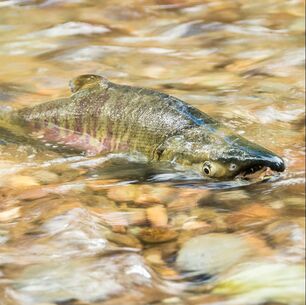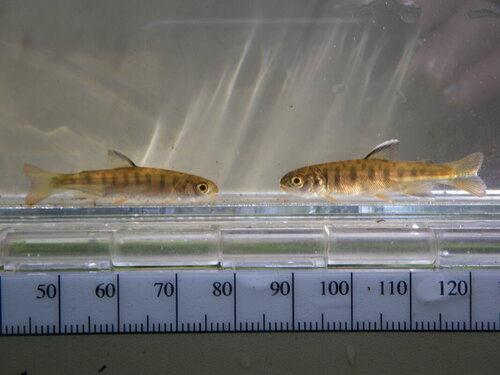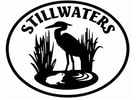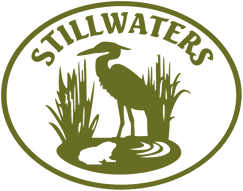Salmon return to Kitsap streams to spawn

Once autumn rains start increasing stream flows in October or November, salmon return to Kitsap lowland streams to spawn. Salmon eager to get upstream are very good at navigating natural obstacles, including short stretches of shallow water and beaver dams. The most common salmon species in Kitsap streams are coho and chum. Coho are good leapers, well able to get past beaver dams and small log jams that they can't swim under or through. Chum are just as determined, but better known for wriggling across flooded roads (click here for video) and over beaver dams (click here for video).
(Right: Chum salmon navigating a stream; note the tiger-striped sides which help camouflage the fish and distinguish this species. Photo credit: John Williams.)
Pacific salmon are very adaptable – one reason there are several species here as opposed to the single species in the Atlantic. Different species differ in timing of migration to the ocean as juveniles and in when and where adults spawn upon their return. Historically (natural history!), salmon reproduced in virtually every creek and river on the Pacific coast. Chinook and sockeye typically frequent larger watersheds with rivers and longer streams, sometimes swimming hundreds of miles upstream to spawn. Meanwhile, coho and chum regularly spawn in smaller streams common in Kitsap County. Fall chum can even reproduce in creeks that dry up in summer because adults return after fall rains begin and juveniles move downstream to salt water in the spring, within weeks of hatching. Coho prefer streams with wetlands that provide year-round flows because most juveniles spend at least one year in freshwater before migrating to the ocean.
(Right: Chum salmon navigating a stream; note the tiger-striped sides which help camouflage the fish and distinguish this species. Photo credit: John Williams.)
Pacific salmon are very adaptable – one reason there are several species here as opposed to the single species in the Atlantic. Different species differ in timing of migration to the ocean as juveniles and in when and where adults spawn upon their return. Historically (natural history!), salmon reproduced in virtually every creek and river on the Pacific coast. Chinook and sockeye typically frequent larger watersheds with rivers and longer streams, sometimes swimming hundreds of miles upstream to spawn. Meanwhile, coho and chum regularly spawn in smaller streams common in Kitsap County. Fall chum can even reproduce in creeks that dry up in summer because adults return after fall rains begin and juveniles move downstream to salt water in the spring, within weeks of hatching. Coho prefer streams with wetlands that provide year-round flows because most juveniles spend at least one year in freshwater before migrating to the ocean.

Kitsap Salmon Tours are back in-person for 2022 on Saturday, November 5th from 10 AM to 2 PM. Biologists and knowledgeable volunteers will be available to answer questions at seven stream sites across the county where the public can observe salmon returning to spawn. Stillwaters will be at the Grover Creek Hatchery site. Kingston's Carpenter Creek is not a Salmon Tours site, but salmon can sometimes be seen gathering on the cove side of the South Kingston Bridge at Arness Park. Splashes and the red body color of male coho give them away as they wait in the large pool there for higher tides that allow them to navigate the estuary more safely and easily.

Spawned-out adults, salmon eggs, and juvenile salmonids have all been observed in Carpenter Creek during Stillwaters’ monitoring. The Wild Fish Conservancy also documented “exceptionally healthy and robust” young-of-the-year (fry) and year-old (parr) coho in the creek via electrofishing during their water-type assessments to identify fish-bearing streams. Electrofishing temporarily stuns fish for easy capture and precise identification of age, species and health (see https://wildfishconservancy.org/wfc/ for stream maps and more information).
(Right: Young-of-the-year coho fry found in Trillium Creek, a Carpenter Creek tributary, during Wild Fish Conservancy water-typing. Water-typing is a process for classifying a stream as fish-bearing which determines the legal protections a stream receives (e.g., width of buffer zones, etc.). Photo credit: Wild Fish Conservancy.)
Visit Stillwaters' Salmon page (here) for more information about salmon in Carpenter Creek and the Kingston estuary and nearshore.

